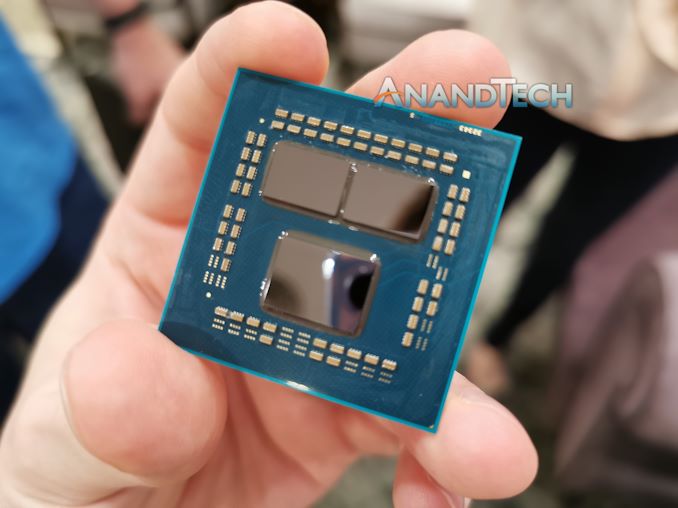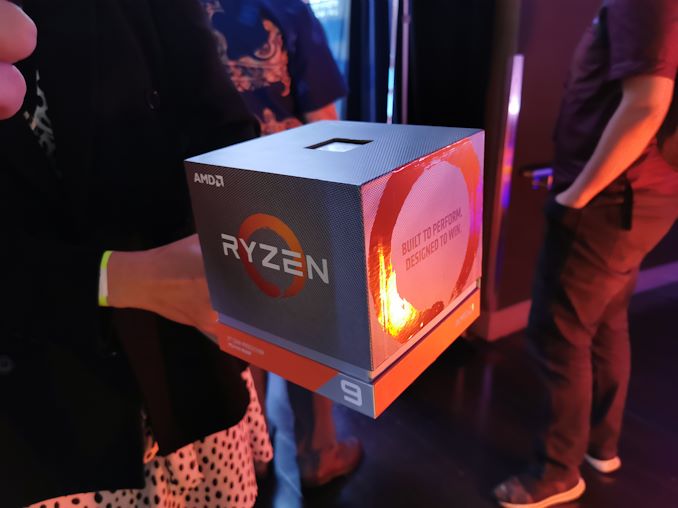AMD 16-Core Ryzen 9 3950X: Up to 4.7 GHz, 105W, Coming September
by Dr. Ian Cutress on June 11, 2019 6:00 PM EST- Posted in
- CPUs
- AMD
- Ryzen
- Zen 2
- Ryzen 3000
- Ryzen 3rd Gen
- Ryzen 9
- 3950X

One of the questions that was left over from AMD’s Computex reveal of the new Ryzen 3000 family was why a 16-core version of the dual-chiplet Matisse design was not announced. Today, AMD is announcing its first 16 core CPU into the Ryzen 9 family. AMD stated that they’re not interested in the back and forth with its competition about slowly moving the leading edge in consumer computing – they want to launch the best they have to offer as soon as possible, and the 16-core is part of that strategy.
The new Ryzen 9 3950X will top the stack of new Zen 2 based AMD consumer processors, and is built for the AM4 socket along with the range of X570 motherboards. It will have 16 cores with simultaneous multi-threading, enabling 32 threads, with a base frequency of 3.5 GHz and a turbo frequency of 4.7 GHz. All of this will be provided in a 105W TDP.
| AMD 'Matisse' Ryzen 3000 Series CPUs | |||||||||||
| AnandTech | Cores Threads |
Base Freq |
Boost Freq |
L2 Cache |
L3 Cache |
PCIe 4.0 |
DDR4 | TDP | Price (SEP) |
||
| Ryzen 9 | 3950X | 16C | 32T | 3.5 | 4.7 | 8 MB | 64 MB | 16+4+4 | ? | 105W | $749 |
| Ryzen 9 | 3900X | 12C | 24T | 3.8 | 4.6 | 6 MB | 64 MB | 16+4+4 | ? | 105W | $499 |
| Ryzen 7 | 3800X | 8C | 16T | 3.9 | 4.5 | 4 MB | 32 MB | 16+4+4 | ? | 105W | $399 |
| Ryzen 7 | 3700X | 8C | 16T | 3.6 | 4.4 | 4 MB | 32 MB | 16+4+4 | ? | 65W | $329 |
| Ryzen 5 | 3600X | 6C | 12T | 3.8 | 4.4 | 3 MB | 32 MB | 16+4+4 | ? | 95W | $249 |
| Ryzen 5 | 3600 | 6C | 12T | 3.6 | 4.2 | 3 MB | 32 MB | 16+4+4 | ? | 65W | $199 |
AMD has said that the processor will be coming in September 2019, about two months after the initial Ryzen 3rd Gen processors, due to extra validation requirements. The chip uses two of the Zen 2 eight-core chiplets, paired with an IO die that provides 24 total PCIe 4.0 lanes. By using the AM4 socket, AMD recommends pairing the Ryzen 9 3950X with one of the new X570 motherboards launched at Computex.
With regards to performance, AMD is promoting it as a clear single-thread and multi-thread improvement over other 16-core products in the market, particularly those from Intel (namely the 7960X).
There are several questions surrounding this new product, such as reasons for the delay between the initial Ryzen 3000 launch to the 3950X launch, the power distribution of the chiplets based on the frequency and how the clocks will respond to the 105W TDP, how the core-to-core communications will work going across chiplets, and how gaming performance might be affected by the latency differences going to the IO die and then moving off to main memory. All these questions are expected to be answered in due course.
Pricing is set to be announced by AMD at its event at E3 today. We’ll be updating this news post when we know the intended pricing.
Update: $749
Related Reading
- AMD Ryzen 3000 Announced: Five CPUs, 12 Cores for $499, Up to 4.6 GHz, PCIe 4.0, Coming 7/7
- AMD Ryzen 3rd Gen 'Matisse' Coming Mid 2019: Eight Core Zen 2 with PCIe 4.0 on Desktop
- AMD: 3rd Gen Ryzen Threadripper in 2019
- AMD Confirms PCIe 4.0 Not Coming to Older Motherboards (X470, X370, B350, A320)
- ASUS Pro WS X570-Ace: A No-Nonsense All-Black Motherboard with x8/x8/x8
- GIGABYTE Unveils X570 Mini-ITX Motherboard: X570 I Aorus Pro WiFi
- ASRock X570 Aqua: Heaviest AMD Flagship Motherboard Ever (Plus Thunderbolt)
- MSI Unveils the MEG X570 Ace: Black and Gold For AMD 50












172 Comments
View All Comments
Oxford Guy - Tuesday, June 11, 2019 - link
The Stilt said better binning typically means lower leakage which means, counterintuitively, that the chip needs MORE voltage for higher clocks.People constantly make the mistake of assuming that good binning (low leakage) translates into less operating voltage needed at higher clocks. No, that would be higher-leakage parts. He said that under air and regular water (non-chilled) conditions it's better to have the lower leakage.
Oxford Guy - Tuesday, June 11, 2019 - link
ASUS apparently capitalized on this mistaken assumption in its Crosshair board for AM3+, where it would underreport the amount of voltage being used, making people assume that they got luckier with the silicon lottery and/or that the board is just so much better.In reality, you were more likely to degrade your chip by putting more voltage into it than was safe.
Oxford Guy - Tuesday, June 11, 2019 - link
Another reason for the assumption is that poorer-quality boards tend to have looser power regulation so they need higher operating voltages to stabilize due to the wilder swings/droop.Setting the UD3P 970 board, for example, to Medium LLC, resulted in much more uniform voltage than anything higher or lower. Some boards didn't even have LLC.
Gastec - Wednesday, June 19, 2019 - link
I guess that's a normal power draw for a 1.4vcore, 4.2 GHz overclock.ksec - Tuesday, June 11, 2019 - link
I have yet to see a single report that resemble those numbers. So unless you could prove that you are effectively spreading fake news.Gastec - Wednesday, June 19, 2019 - link
I have no need for 16-cores, but I'll take a 8-core CPU that draws 70-80 W for $330.MDD1963 - Wednesday, June 12, 2019 - link
Intel had a 16 core Atom C3958 (SOC) at 31 watts TDP ...14 months ago...; does that count?Zok - Monday, June 10, 2019 - link
Time for an upgrade from my i7 7700K! I'm torn between the 3900X and 3950X though. Will wait to see which one results in better OC. Fewer cores vs better binning.12345 - Monday, June 10, 2019 - link
I have a feeling PBO will be amazing this generation. 2nd gen is so limited by how fragile 12nm is.anonomouse - Monday, June 10, 2019 - link
There's plenty of other questions about this thing, the biggest of which I see is how the performance scaling on multithreaded workloads looks given that the bandwidth is still limited to two channels of DDR4 and frequencies have definitely not doubled here to match the core scaling.